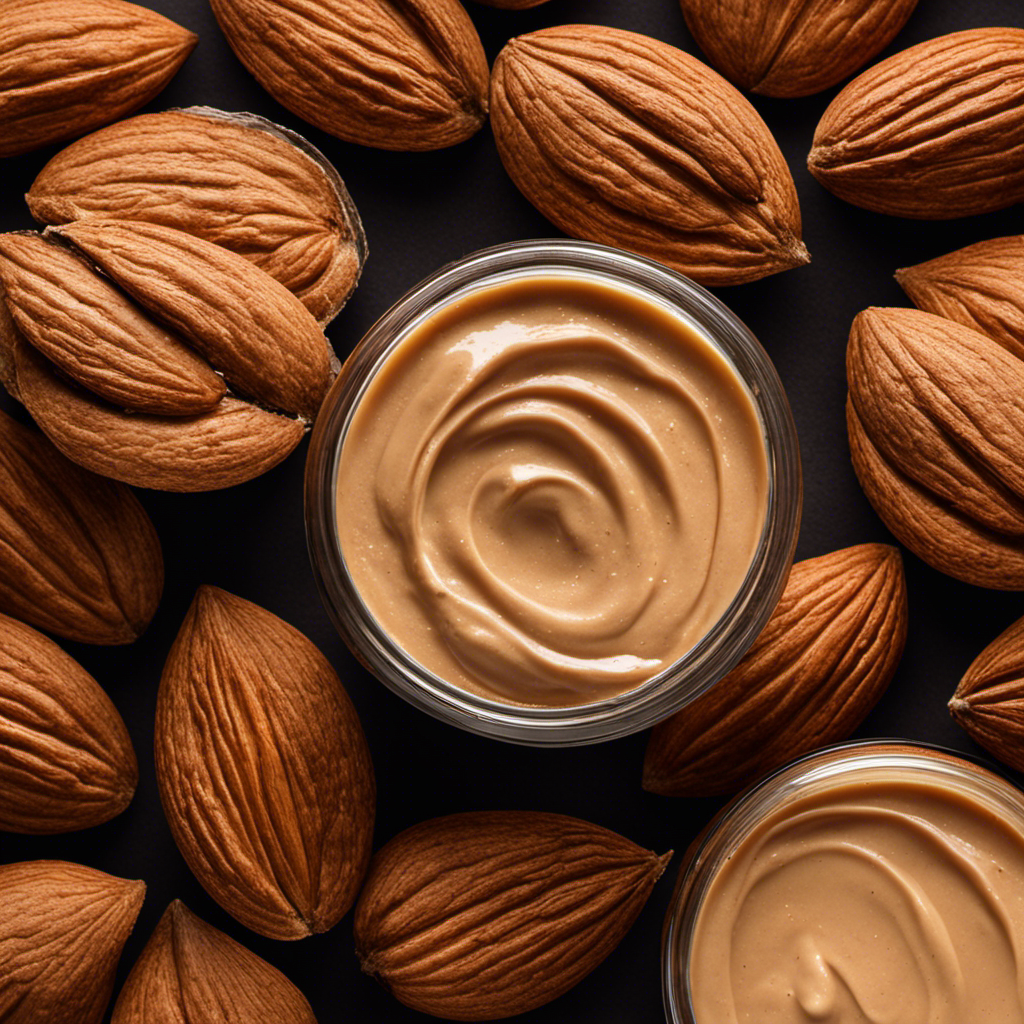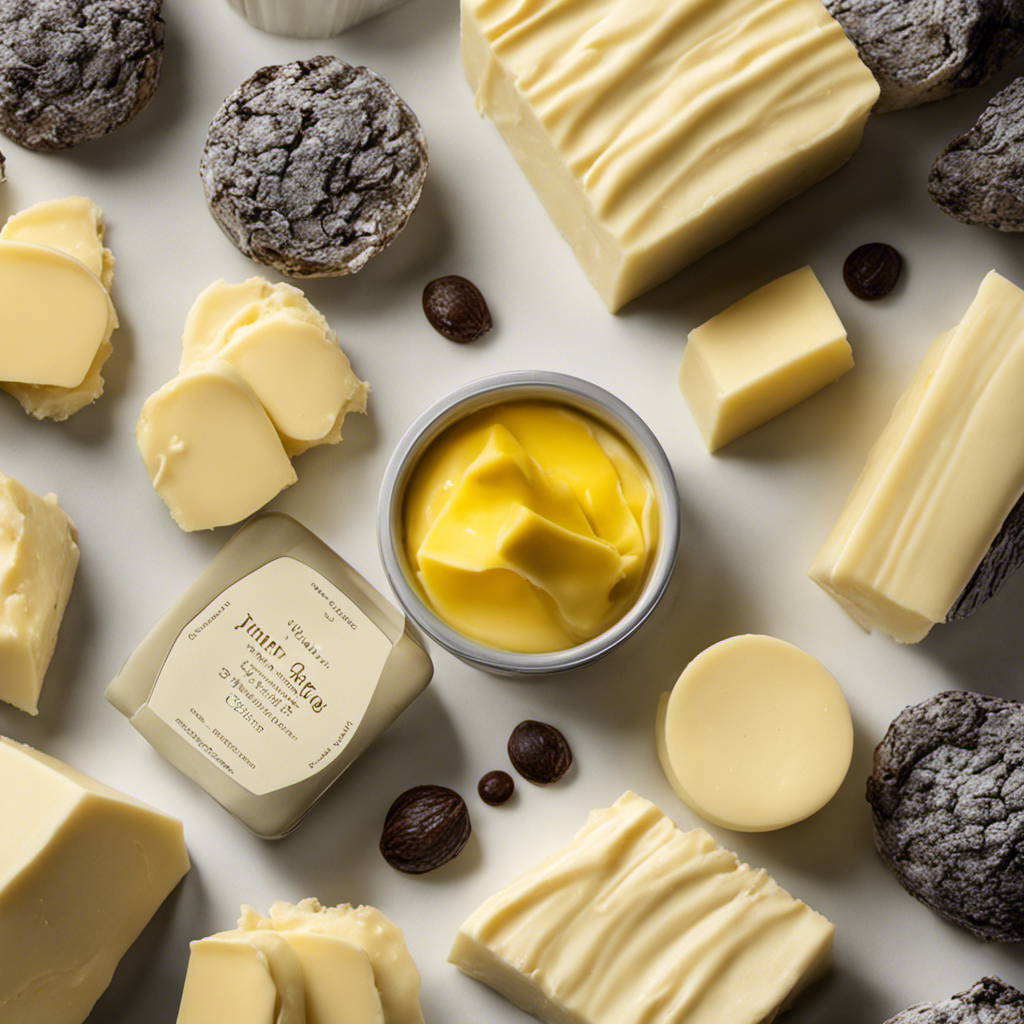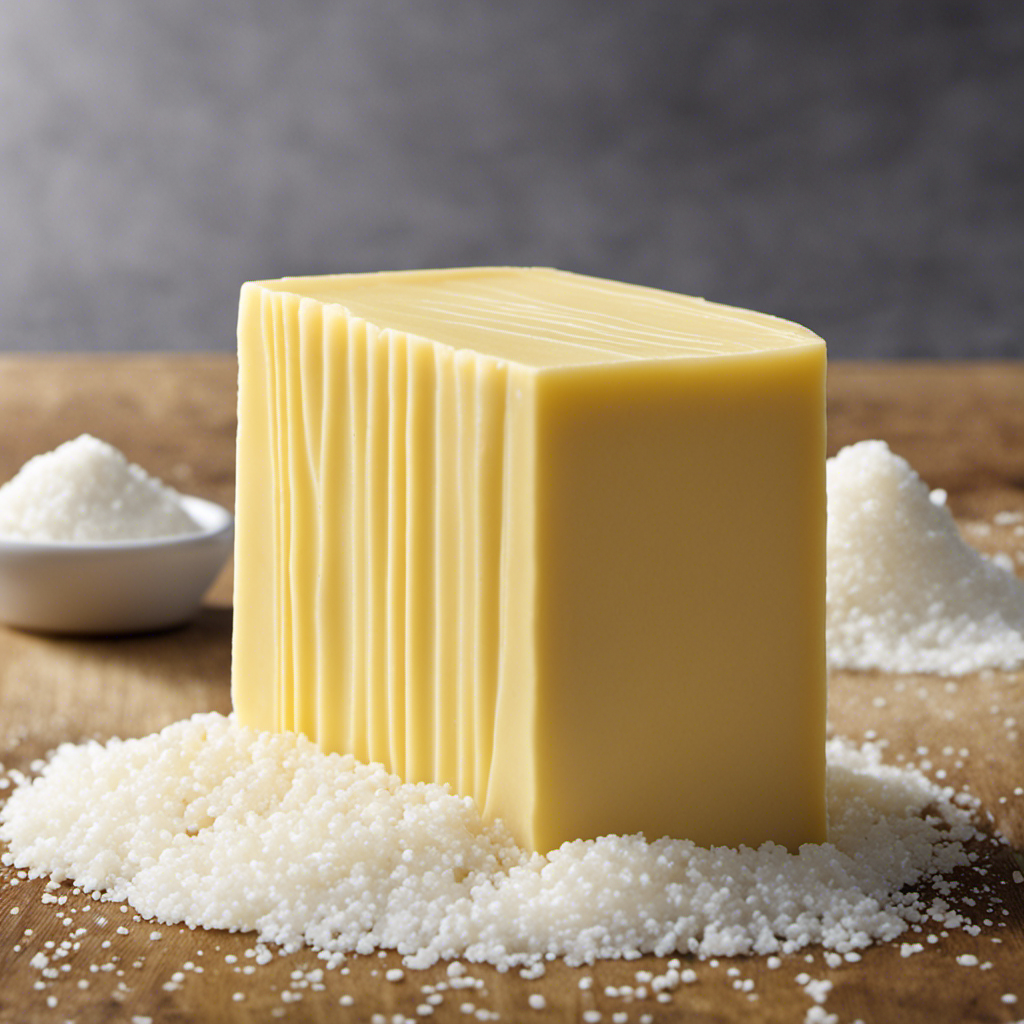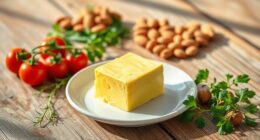As a lover of almonds, I often contemplate the dangers of spoiled butter. Today, my fellow almond fans, we set out to uncover the indications of rancidity in our cherished almond butter.
From the expiration date to the appearance, texture, smell, and taste, we shall leave no stone unturned. Prepare yourselves for a journey through the realms of oil separation, mold, discoloration, and rancid flavors.
Fear not, for armed with knowledge, we shall conquer any bad almond butter that dares cross our palates.
Key Takeaways
- Pay attention to the expiration date and consume almond butter within 3 to 6 months after opening for the best flavor.
- Store almond butter in a cool, dry place to prevent mold growth and discoloration.
- Check for a rancid smell or taste, as well as any mold or discoloration, to determine if almond butter is spoiled.
- Proper storage, such as refrigeration and tightly sealing the jar, can help maintain the freshness and prevent an unpleasant odor in almond butter.
Expiration Date
The expiration date on almond butter indicates when it’s no longer fresh. It is important to pay attention to this date to ensure the quality and taste of the almond butter.
The shelf life of almond butter can vary depending on the brand and storage conditions. Generally, unopened almond butter can last for about six months to a year past its expiration date. However, once opened, it is recommended to consume it within three to six months for the best flavor.
To extend the shelf life of almond butter, it is important to store it properly. Keep it in a cool, dry place away from direct sunlight. It is also advisable to refrigerate the almond butter after opening to slow down the oxidation process and maintain its freshness.
Appearance
When it comes to determining the quality of almond butter, there are a few key points to consider.
First, check for any signs of mold or discoloration. If you notice any growth or a change in color, it’s a clear indication that the almond butter has gone bad.
Additionally, pay attention to the smell and taste. If the almond butter has a rancid odor or taste, it’s best to discard it.
Mold or Discoloration
If you see any mold or discoloration in your almond butter, it’s time to throw it out. Mold can develop on almond butter when it is exposed to moisture or if it is stored improperly. To prevent mold growth, it is important to store your almond butter in a cool, dry place. Avoid exposing it to direct sunlight or high temperatures, as this can cause the oil in the almond butter to separate and create an ideal environment for mold growth.
Additionally, make sure to always use a clean utensil when scooping out almond butter to prevent any contamination. If you notice any discoloration, such as a green or black tint, it is a clear sign that mold has started to grow, and it is best to discard the entire jar to avoid any potential health risks.
Rancid Smell or Taste
Check for a strong, unpleasant smell or taste in your almond butter – it’s a clear indication that it has gone rancid and should be discarded. Rancidity occurs when the natural fats in the almond butter break down, resulting in a foul odor and taste.
To determine if your almond butter has gone bad, follow these steps:
-
Smell: Take a whiff of the almond butter. If it smells off, sour, or generally unpleasant, it’s a sign of rancidity.
-
Taste: If you’re brave enough, give the almond butter a small taste. Rancid almond butter will have a bitter, metallic, or soapy taste that is unmistakable.
-
Visual inspection: While not always a reliable indicator, check for any visible signs of mold or discoloration. Rancid almond butter may appear darker in color or have a slimy texture.
Separation or Clumping
To fix the separation or clumping in your almond butter, simply give it a good stir or mix it well to restore its smooth consistency.
Separation or clumping is a common issue with natural almond butter due to the absence of stabilizers. Over time, the oils in the almond butter tend to rise to the top, causing separation. This is a natural process and does not indicate that the almond butter has gone bad.
However, if the separation or clumping is accompanied by an off smell or taste, it may be a sign of spoilage.
To prevent this, make sure to store your almond butter in a cool, dry place away from direct sunlight. Proper storage conditions and a sealed container can help extend the shelf life of your almond butter and maintain its smooth texture.
Texture
You can tell if your almond butter has gone bad by feeling for any clumps or graininess in its texture. Over time, almond butter may undergo textural changes that indicate it is no longer safe to consume. Here are three signs to look out for:
-
Presence of clumps or graininess: If your almond butter feels lumpy or has a gritty texture, it may have spoiled. This can occur when the oils in the almond butter separate and solidify.
-
Mold or discoloration: Inspect the almond butter for any signs of mold growth or unusual colors. These are clear indications that it has gone bad and should be discarded.
-
Rancid smell: A strong, unpleasant odor coming from the almond butter is another indicator that it is no longer fresh. This smell is caused by the oils in the almonds oxidizing over time.
It is important to note that the shelf life of almond butter can vary depending on factors such as the brand, storage conditions, and whether it is homemade or store-bought. Always check the expiration date and use your senses to determine if it is still safe to eat.
Smell
When it comes to determining whether a food is spoiled or not, smell plays a crucial role. An off-putting odor can be a clear indicator that something is wrong with the food.
Whether it’s a rancid scent or an unpleasant smell, our noses are often the first line of defense in detecting spoiled food and protecting ourselves from potential harm.
Off-Putting Odor Indicator
If almond butter has a strong, unpleasant odor, it’s a clear sign that it may be bad. The smell of almond butter should be nutty and slightly sweet, so any off-putting odors should not be ignored.
Here are some remedies to consider if you encounter this issue:
-
Store the almond butter in the refrigerator: This can help preserve its freshness and prevent the development of a rancid smell.
-
Check the expiration date: Almond butter, like any other food product, has a shelf life. Make sure to consume it before the expiration date to avoid any unpleasant smells.
-
Consider alternative almond butter options: If you consistently experience bad odors with your almond butter, it might be worth trying different brands or making your own at home.
Rancid Scent Detection
Detecting a rancid scent in your almond butter is a clear sign that it may have gone bad. The quality of almond butter can be greatly affected by improper storage conditions. When exposed to air, light, and heat, the oil in almond butter can become oxidized, leading to a rancid smell and taste.
To ensure the best quality and prolong the shelf life of your almond butter, it is important to store it in a cool, dark place, away from direct sunlight and heat sources. Additionally, tightly sealing the jar after each use can help prevent air from entering and causing oxidation.
By following these storage guidelines, you can minimize the chances of encountering a rancid scent in your almond butter and enjoy its fresh and delicious flavor for longer.
However, an unpleasant smell is not the only warning sign that your almond butter may have gone bad.
Unpleasant Smell Warning
Storing almond butter in improper conditions can greatly affect its quality, leading to an unpleasant smell and taste. Detecting an unpleasant odor is a clear indication that the almond butter has gone bad.
To help you determine if your almond butter is still fresh, here are some freshness indicators to look out for:
-
Visual Inspection: Check for any discoloration or mold growth on the surface of the almond butter.
-
Texture Test: Feel the consistency of the almond butter. If it has become grainy or clumpy, it may be a sign of spoilage.
-
Taste Test: Take a small amount and taste it. If it tastes rancid or has a bitter flavor, it’s best to discard it.
Taste
To determine if your almond butter has gone bad, simply taste it and see if it has a rancid or off flavor. Off flavor detection is an important aspect of sensory evaluation when it comes to food products.
When I taste the almond butter, I pay close attention to any unusual or unpleasant taste. A rancid or off flavor can be a sign that the almond butter is spoiled or has been stored improperly. It might have a sour, bitter, or metallic taste that is different from the usual nutty flavor.
Additionally, spoiled almond butter can have a greasy or slimy texture. If I detect any of these signs, it’s best to discard the almond butter to avoid any potential health risks.
Oil Separation
When you see oil separation in your almond butter, simply give it a stir before using to redistribute the oils. This is a common occurrence in natural almond butter due to its high oil content. It is not a sign of spoilage or a decrease in oil quality, but rather a natural process.
However, the presence of oil separation can be influenced by storage conditions. To ensure the best quality and taste of your almond butter, it is recommended to store it in a cool, dry place away from direct sunlight and heat sources. Avoid exposing it to fluctuating temperatures or humidity, as this can accelerate oil separation.
Mold or Discoloration
As I mentioned earlier, one of the signs that almond butter has gone bad is the presence of mold or discoloration. Mold can develop on almond butter if it has been stored improperly or for too long. To prevent mold growth, it is important to store almond butter in a cool, dry place away from direct sunlight. Additionally, make sure to tightly seal the jar after each use to minimize exposure to air and moisture.
Here is a table summarizing some tips for mold prevention and proper storage of almond butter:
| Mold Prevention Tips | Proper Storage |
|---|---|
| Store in a cool, dry place | Keep away from direct sunlight |
| Ensure jar is tightly sealed | Minimize exposure to air and moisture |
| Check for signs of mold or discoloration before consuming | Use within the recommended shelf life |
Rancid or Off Flavors
One indicator that almond butter may have spoiled is if it has a rancid or off taste. This is crucial to detecting the quality of the almond butter.
To ensure that your almond butter is still fresh and safe to consume, consider the following points:
-
Check the expiration date: Always look for the expiration date on the packaging. If the almond butter has expired, it is more likely to have developed off flavors.
-
Smell test: Take a whiff of the almond butter. If it has a sour or unpleasant odor, it may have gone bad.
-
Taste test: Take a small amount of the almond butter and taste it. If it has a strange or off flavor, it is a clear sign that it is no longer good to eat.
Allergen Testing
Now that we have discussed the potential for rancid or off flavors in almond butter, let’s shift our focus to allergen testing.
It is crucial for individuals with allergies to know if a product contains allergens that could trigger a reaction. Allergen labeling is required by law in many countries, including the United States. This means that almond butter manufacturers must clearly indicate if their product contains common allergens such as peanuts or tree nuts.
However, it’s important to note that cross-contamination risks can still exist, especially in facilities that process multiple types of nuts. To mitigate these risks, some manufacturers conduct allergen testing to ensure that their almond butter is free from any traces of allergens.
This additional step provides peace of mind to consumers with allergies, allowing them to confidently enjoy their almond butter without worrying about potential reactions.
Frequently Asked Questions
Can I Still Consume Almond Butter if It Has Passed Its Expiration Date?
I can still consume expired almond butter, but it may not taste as fresh or have the same texture. To properly store almond butter, keep it in a cool, dry place and refrigerate after opening.
Is It Normal for Almond Butter to Have a Slightly Grainy Texture?
Yes, it’s normal for almond butter to have a slightly grainy texture. To prevent this, store it properly by keeping it in a cool, dry place. For homemade almond butter, blend it longer for a smoother texture.
Can the Smell of Almond Butter Indicate Whether It Has Gone Bad or Not?
The smell of almond butter can indicate spoilage. If it smells rancid or off, it’s best to discard it. To prevent almond butter from going bad, store it in a cool, dry place and keep it tightly sealed.
What Should I Do if My Almond Butter Tastes Slightly Bitter or Sour?
If my almond butter tastes slightly bitter or sour, I would check the expiration date and storage conditions. To prevent this, store almond butter in a cool, dry place and avoid exposing it to heat or moisture.
Are There Any Common Allergens That May Be Present in Almond Butter?
There are potential allergic reactions to almond butter due to cross contamination risks with other allergens. It’s important to read labels and check for any potential allergens before consuming almond butter.
Conclusion
In conclusion, determining if almond butter has gone bad requires keen observation of various factors. Just like a seasoned detective solving a mysterious case, you must carefully examine the expiration date, appearance, texture, smell, and taste.
Pay attention to any signs of oil separation, mold, or discoloration, as well as the presence of rancid or off flavors. Additionally, allergen testing can provide further assurance.
By taking these steps, you can ensure your almond butter is fresh and delicious, like a perfectly baked batch of cookies.










